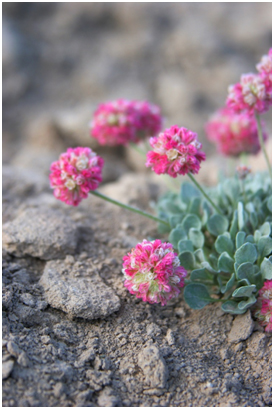Eriogonum ovalifolium in the Landscape

Stephen Love, University of Idaho
Scientfic Name: Eriogonum ovalifoliumCommon Name: Oval-leaf Buckwheat
Description: Mound-forming perennial with a woody crown. Beautiful silver leaves grow to 4 inches tall and form a mat up to a foot wide. In May and June white, buff, or yellow pom-pom flowers form on short stems. As the flowers age, they may change color to shades of pink, red, or purple. The flowers remain attractive for five to six weeks. Oval-leaf buckwheat is a good subject for the xeric bed or rock garden.
Native Habitat: Found throughout the Rocky Mountain and Great Basin regions at moderate to high elevations. Typically grows on rocky slopes with scattered small brush and grasses. Hardiness zones 3-6.
Cultural Requirement
Soil: Neutral or alkaline; well-drained; shallow, nutrient-poor soils.
Moisture Tolerance: Xeric conditions or limited supplemental irrigation.
Sun/Shade/Preference: Full sun.
Transplanting: Seedlings may damp off; plants with 4-6 leaves transplant easily.
Propagation: Best from seed; stem cuttings can be used with some success.
Maintenance (pruning, fertilization, deadheading, division, irrigation, etc): Easy to care for; remove dead flower stems to improve appearance; add little or no fertilizer to established plants, use minimal or no supplemental.
Insect, disease, or other problems: None of concern.
Landscape Value
Use in the Landscape: Especially effective in xeric rock gardens; useful in borders with other small plants.
Foliage: Mounds of silver leaves are attractive all summer.
Flower: Pom-pom shaped flower heades grow on short stems.
Timing: May-June
Color: Shades of white, pink, red or purple.
Fruit: Inconspicuous achene enclosed in a dried perianth.
Form: Small mat or mound.
Texture: Dense, fine.
Ultimate Size: Four inches tall by one foot wide.
Rate of Growth: Slow, flowers the second year.
Suggested Plant Partners: Penstemon species, sundancer daisy, blue fescue.
Availability: Occasionally available at specialty mail-order nurseries.
Cultivars: None; (best botanical varieties include nivale, depressus, and purpureum)
References:

